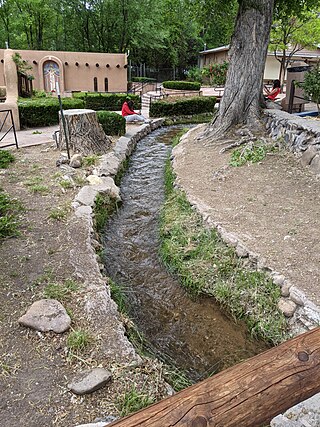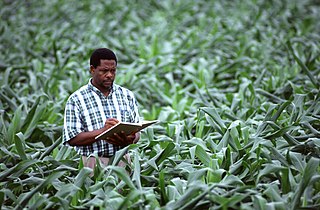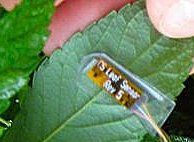
Center-pivot irrigation, also called water-wheel and circle irrigation, is a method of crop irrigation in which equipment rotates around a pivot and crops are watered with sprinklers. A circular area centered on the pivot is irrigated, often creating a circular pattern in crops when viewed from above. Most center pivots were initially water-powered, however today most are propelled by electric motors.

Intensive agriculture, also known as intensive farming, conventional, or industrial agriculture, is a type of agriculture, both of crop plants and of animals, with higher levels of input and output per unit of agricultural land area. It is characterized by a low fallow ratio, higher use of inputs such as capital, labour, agrochemicals and water, and higher crop yields per unit land area.

Sustainable agriculture is farming in sustainable ways meeting society's present food and textile needs, without compromising the ability for current or future generations to meet their needs. It can be based on an understanding of ecosystem services. There are many methods to increase the sustainability of agriculture. When developing agriculture within sustainable food systems, it is important to develop flexible business processes and farming practices. Agriculture has an enormous environmental footprint, playing a significant role in causing climate change, water scarcity, water pollution, land degradation, deforestation and other processes; it is simultaneously causing environmental changes and being impacted by these changes. Sustainable agriculture consists of environment friendly methods of farming that allow the production of crops or livestock without causing damage to human or natural systems. It involves preventing adverse effects on soil, water, biodiversity, and surrounding or downstream resources, as well as to those working or living on the farm or in neighboring areas. Elements of sustainable agriculture can include permaculture, agroforestry, mixed farming, multiple cropping, and crop rotation.

Water conservation aims to sustainably manage the natural resource of fresh water, protect the hydrosphere, and meet current and future human demand. Water conservation makes it possible to avoid water scarcity. It covers all the policies, strategies and activities to reach these aims. Population, household size and growth and affluence all affect how much water is used.

An acequia or séquia is a community-operated watercourse used in Spain and former Spanish colonies in the Americas for irrigation. Acequias are found in parts of Spain, the Andes, northern Mexico, and the modern-day American Southwest.

Dryland farming and dry farming encompass specific agricultural techniques for the non-irrigated cultivation of crops. Dryland farming is associated with drylands, areas characterized by a cool wet season followed by a warm dry season. They are also associated with arid conditions, areas prone to drought and those having scarce water resources.

No-till farming is an agricultural technique for growing crops or pasture without disturbing the soil through tillage. No-till farming decreases the amount of soil erosion tillage causes in certain soils, especially in sandy and dry soils on sloping terrain. Other possible benefits include an increase in the amount of water that infiltrates into the soil, soil retention of organic matter, and nutrient cycling. These methods may increase the amount and variety of life in and on the soil. While conventional no-tillage systems use herbicides to control weeds, organic systems use a combination of strategies, such as planting cover crops as mulch to suppress weeds.
Natural Resources Conservation Service (NRCS), formerly known as the Soil Conservation Service (SCS), is an agency of the United States Department of Agriculture (USDA) that provides technical assistance to farmers and other private landowners and managers.

Nutrient management is the science and practice directed to link soil, crop, weather, and hydrologic factors with cultural, irrigation, and soil and water conservation practices to achieve optimal nutrient use efficiency, crop yields, crop quality, and economic returns, while reducing off-site transport of nutrients (fertilizer) that may impact the environment. It involves matching a specific field soil, climate, and crop management conditions to rate, source, timing, and place of nutrient application.

Rainwater harvesting (RWH) is the collection and storage of rain, rather than allowing it to run off. Rainwater is collected from a roof-like surface and redirected to a tank, cistern, deep pit, aquifer, or a reservoir with percolation, so that it seeps down and restores the ground water. Rainwater harvesting differs from stormwater harvesting as the runoff is typically collected from roofs and other area surfaces for storage and subsequent reuse. Its uses include watering gardens, livestock, irrigation, domestic use with proper treatment, and domestic heating. The harvested water can also be used for long-term storage or groundwater recharge.

An agriculturist, agriculturalist, agrologist, or agronomist is a professional in the science, practice, and management of agriculture and agribusiness. It is a regulated profession in Canada, India, the Philippines, the United States, and the European Union. Other names used to designate the profession include agricultural scientist, agricultural manager, agricultural planner, agriculture researcher, or agriculture policy maker.
Water trading is the process of buying and selling water access entitlements, also often called water rights. The terms of the trade can be either permanent or temporary, depending on the legal status of the water rights. Some of the western states of the United States, Chile, South Africa, Australia, Iran and Spain's Canary Islands have water trading schemes. Some consider Australia's to be the most sophisticated and effective in the world. Some other countries, especially in South Asia, also have informal water trading schemes. Water markets tend to be local and informal, as opposed to more formal schemes.

A leaf sensor is a phytometric device that measures water loss or the water deficit stress (WDS) in plants by real-time monitoring the moisture level in plant leaves. The first leaf sensor was developed by LeafSens, an Israeli company granted a US patent for a mechanical leaf thickness sensing device in 2001. LeafSen has made strides incorporating their leaf sensory technology into citrus orchards in Israel. A solid state smart leaf sensor technology was developed by the University of Colorado at Boulder for NASA in 2007. It was designed to help monitor and control agricultural water demand. AgriHouse received a National Science Foundation (NSF) STTR grant in conjunction with the University of Colorado to further develop the solid state leaf sensor technology for precision irrigation control in 2007.
Water resources and irrigation infrastructure in Peru vary throughout the country. The coastal region, an arid but fertile land, has about two-thirds of Peru's irrigation infrastructure due to private and public investment aimed at increasing agricultural exports. The Highlands and Amazon regions, with abundant water resources but rudimentary irrigation systems, are home to the majority of Peru's poor, many of whom rely on subsistence or small-scale farming.
Mexico, a classified arid and semi-arid country, has a total land area of 2 million square kilometres, 23% of which is equipped for irrigated agriculture. The agricultural sector plays an important role in the economic development of the country accounting for 8.4 of agricultural gross domestic product (GDP) and employing 23% of the economically active population. Irrigated agriculture contributes about 50% of the total value of agricultural production and accounts for about 70% of agriculture exports. Mexico's government initiated a number of structural reforms in the water sector aimed to introduce modern water management and irrigation.

Farm water, also known as agricultural water, is water committed for use in the production of food and fibre and collecting for further resources. In the US, some 80% of the fresh water withdrawn from rivers and groundwater is used to produce food and other agricultural products. Farm water may include water used in the irrigation of crops or the watering of livestock. Its study is called agricultural hydrology.
Deficit irrigation (DI) is a watering strategy that can be applied by different types of irrigation application methods. The correct application of DI requires thorough understanding of the yield response to water and of the economic impact of reductions in harvest. In regions where water resources are restrictive it can be more profitable for a farmer to maximize crop water productivity instead of maximizing the harvest per unit land. The saved water can be used for other purposes or to irrigate extra units of land. DI is sometimes referred to as incomplete supplemental irrigation or regulated DI.

The Environmental Quality Incentives Program (EQIP) is a United States government program designed to assist farmers in improving environmental quality, particularly water quality and soil conservation. Congress established the program in the 1996 farm bill to provide primarily cost-sharing assistance, but also technical and educational assistance, aimed at promoting production and environmental quality, and optimizing environmental benefits.
Irrigation is the artificial exploitation and distribution of water at project level aiming at application of water at field level to agricultural crops in dry areas or in periods of scarce rainfall to assure or improve crop production.
This article discusses organizational forms and means of management of irrigation water at project (system) level.

Large scale rice production in the state of Arkansas became a significant industry in the late 19th/early 20th century with its wide scale propagation within the state by entrepreneur W.H. Fuller around 1896. Arkansas has historically been the largest rice producer in the entire United States, and accounted for nearly 45% of U.S. rice production in 2001, as well as just less than half of the total number of acres of rice harvested nationwide. Much of Arkansas' rice is grown in the east-central portion of the state, where it requires nearly three times more the amount of irrigation water than the average eleven inches the region receives during the growing season. In the areas of lowest precipitation, or where weedy red rice is a significant problem, farmers follow a three year, three phase "old rotation" of rice-soybean-soybean. However, most Arkansas rice producers follow a two year, two phase crop rotation of rice following soybeans.













